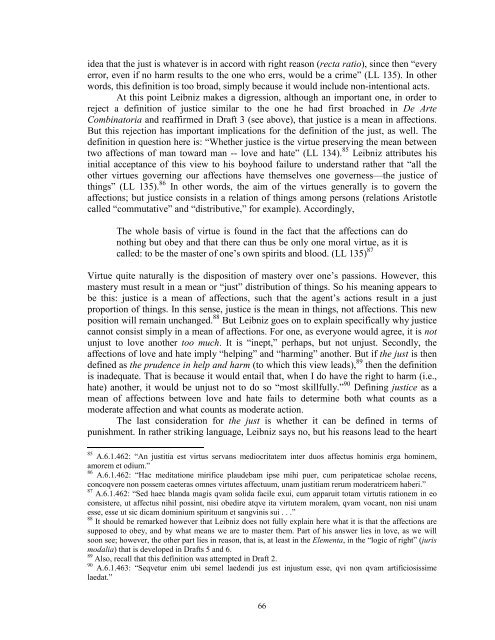Stony Brook University
Stony Brook University
Stony Brook University
Create successful ePaper yourself
Turn your PDF publications into a flip-book with our unique Google optimized e-Paper software.
idea that the just is whatever is in accord with right reason (recta ratio), since then “every<br />
error, even if no harm results to the one who errs, would be a crime” (LL 135). In other<br />
words, this definition is too broad, simply because it would include non-intentional acts.<br />
At this point Leibniz makes a digression, although an important one, in order to<br />
reject a definition of justice similar to the one he had first broached in De Arte<br />
Combinatoria and reaffirmed in Draft 3 (see above), that justice is a mean in affections.<br />
But this rejection has important implications for the definition of the just, as well. The<br />
definition in question here is: “Whether justice is the virtue preserving the mean between<br />
two affections of man toward man -- love and hate” (LL 134). 85 Leibniz attributes his<br />
initial acceptance of this view to his boyhood failure to understand rather that “all the<br />
other virtues governing our affections have themselves one governess—the justice of<br />
things” (LL 135). 86 In other words, the aim of the virtues generally is to govern the<br />
affections; but justice consists in a relation of things among persons (relations Aristotle<br />
called “commutative” and “distributive,” for example). Accordingly,<br />
The whole basis of virtue is found in the fact that the affections can do<br />
nothing but obey and that there can thus be only one moral virtue, as it is<br />
called: to be the master of one’s own spirits and blood. (LL 135) 87<br />
Virtue quite naturally is the disposition of mastery over one’s passions. However, this<br />
mastery must result in a mean or “just” distribution of things. So his meaning appears to<br />
be this: justice is a mean of affections, such that the agent’s actions result in a just<br />
proportion of things. In this sense, justice is the mean in things, not affections. This new<br />
position will remain unchanged. 88 But Leibniz goes on to explain specifically why justice<br />
cannot consist simply in a mean of affections. For one, as everyone would agree, it is not<br />
unjust to love another too much. It is “inept,” perhaps, but not unjust. Secondly, the<br />
affections of love and hate imply “helping” and “harming” another. But if the just is then<br />
defined as the prudence in help and harm (to which this view leads), 89 then the definition<br />
is inadequate. That is because it would entail that, when I do have the right to harm (i.e.,<br />
hate) another, it would be unjust not to do so “most skillfully.” 90 Defining justice as a<br />
mean of affections between love and hate fails to determine both what counts as a<br />
moderate affection and what counts as moderate action.<br />
The last consideration for the just is whether it can be defined in terms of<br />
punishment. In rather striking language, Leibniz says no, but his reasons lead to the heart<br />
85<br />
A.6.1.462: “An justitia est virtus servans mediocritatem inter duos affectus hominis erga hominem,<br />
amorem et odium.”<br />
86<br />
A.6.1.462: “Hac meditatione mirifice plaudebam ipse mihi puer, cum peripateticae scholae recens,<br />
concoqvere non possem caeteras omnes virtutes affectuum, unam justitiam rerum moderatricem haberi.”<br />
87<br />
A.6.1.462: “Sed haec blanda magis qvam solida facile exui, cum apparuit totam virtutis rationem in eo<br />
consistere, ut affectus nihil possint, nisi obedire atqve ita virtutem moralem, qvam vocant, non nisi unam<br />
esse, esse ut sic dicam dominium spirituum et sangvinis sui . . .”<br />
88<br />
It should be remarked however that Leibniz does not fully explain here what it is that the affections are<br />
supposed to obey, and by what means we are to master them. Part of his answer lies in love, as we will<br />
soon see; however, the other part lies in reason, that is, at least in the Elementa, in the “logic of right” (juris<br />
modalia) that is developed in Drafts 5 and 6.<br />
89<br />
Also, recall that this definition was attempted in Draft 2.<br />
90<br />
A.6.1.463: “Seqvetur enim ubi semel laedendi jus est injustum esse, qvi non qvam artificiosissime<br />
laedat.”<br />
66
















